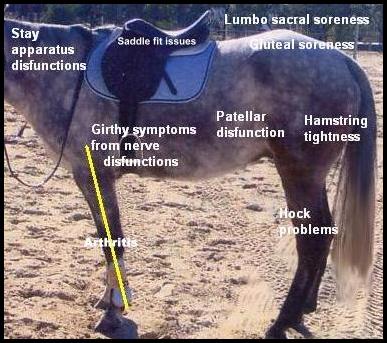
By Chrisann Ware
How to know if your horse has problem hooves?
or
The Idiots Guide to Hoof Problems
(no disrespect meant)!

By Chrisann Ware
Equine Myofunctional Therapist, UHHGM
& Co-ordinator Equethy Barefoot Workshops (Aust.)
As an Equine Myofunctional Therapist
dealing daily with equine musculo-skeletal problems and through Equethy
workshops (who have now delivered hundreds of workshops all over
Australia
in the past seven years), I have had the pleasure to meet many horse owners
who turned to barefoot rehabilitation.
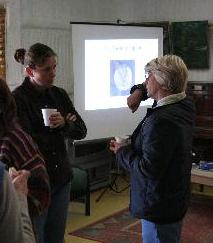 The comment I hear all the time after they see the dramatic changes
that occur both in hooves and bodies is "I wish I had known how to spot
hoof problems earlier.... I could have helped my horse years ago instead of
wasting all that time while he was getting steadily worse......I feel like such
an idiot!"
The comment I hear all the time after they see the dramatic changes
that occur both in hooves and bodies is "I wish I had known how to spot
hoof problems earlier.... I could have helped my horse years ago instead of
wasting all that time while he was getting steadily worse......I feel like such
an idiot!"
I tell them "don't" because you are not alone. I was just the
same at one time until I learned a little hoof anatomy.
Many horse owners
know instinctively that their horses are "not quite right. They ask their
farrier who says "well he doesn't have great feet but just keep him shod and he
will be OK."
So naturally the owner dismisses the hoof as a
source of problems and moves on in their search.... and on.... and on.....and
the horse is seen by a parade of people. All the time getting
slowly worse.
Unless this horse's owner is lucky enough to find a body worker who also has a good knowledge of the hoof/body relationship to musculo-skeletal soundness, and also knows how to spot hoof deformation, the hoof is not usually suspected as the source of the problems. Sadly, many horses never receive the help they need and are left with career ending problems, sometimes life ending problems.
I have put this article together to try to offer some insights for
horse owners who are scratching their heads about where to look next.
There are other ways to spot horses already living with hoof pain other
than becoming a "natural hoof care" expert.
I have
endeavoured to explain a few of the vast number of secondary
musculo-skeletal issues that arise from long term hoof pain. These are
not the rantings of the barefoot obsessed (well only slightly), but there has
recently been a huge amount of research into the hoof by leading veterinary
researchers and there is now the science to support what barefoot
trimmers have been finding at the "coal face" of hoof care for many years
now.
This research has shone a light on the reasons our
domestic horses are so afflicted with hoof problems and thus taken hoof care,
hopefully, out of the dark ages.
Firstly let me say one thing; Horse shoes slowly deform horses' hooves. They alter the very integrity of the structures inside the hoof that were engineered by nature to withstand the huge weight of this animal in motion. They weaken them and this weakness causes the deformation of the hoof and its inner structures.
Don't think it's possible? Just look at our own history and the pictures below from the practice of foot binding during the Tsang Dynasty. "Well, horses are different" I hear you say. Actually the way living tissue and bone reacts to years of unnatural stresses is not as different as you may think. (refer Wolfes Law of Orthopaedics).
|
|
|
|
Steel horse shoes deform, weaken and change the tissues within the hoof. The very structures that were meant to dissipate concussion at ground level and protect the horse are compromised. They deform the hoof capsule by loading only the hoof wall (peripheral loading) and as the capsule changes shape slowly under the impact of unnatural forces, it crushes the inner soft tissue structures in the caudal hoof it was meant to protect, resulting in caudal heel pain and deep seated inflammation. This inflammation goes unnoticed as it requires an MRI scan to see these changes and most vets do not have access to this type of expensive equipment.
Why the caudal (back) hoof area? Because this is where all the soft tissue structures lay inside the hoof capsule. They fill the back half of the hoof and sit behind the pedal bone because the horse, like most mammals was meant to do a heel first stride landing. .
So...depending on the breed, the age of first shoeing and the abilities of those shoeing the horse thereafter to balance the hooves, the deformation can happen very quickly, or slowly over many years, but it will happen. Hoof pain is often the first symptom and begins in the caudal hoof area of the front feet (deep in the heel area) too deep to locate with hoof testers. Once the hoof capsule starts to deform, this is the part of the hoof where the leverage forces from the horse's own weight begin to squash and deform the internal structures.
The hoof will deform by either running forward and becoming splayed and flat. Or start to contract at the heels and become steeper. The type of deformation usually depends on the hoof shape particular to that breed. Below are extreme examples of this. Thoroughbreds & breeds with wider pedal bones tend to acquire under-run long low heels and forward running overly long toes.
Breeds with more conical hooves such as ponies and Arabians tend to deform to become more contracted and steep.
Many horses thought to have navicular syndrome actually have acquired caudal hoof pain stemming from their deformed hooves. Every single case of navicular syndrome displays some degree of hoof deformation! I repeat .......every single one! It is never seen in physiologically correct hooves.
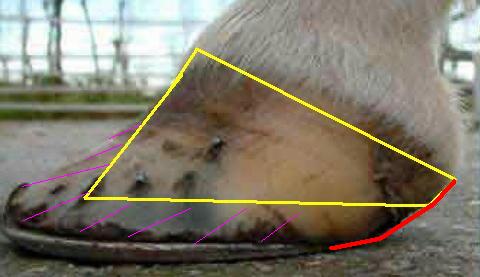 |
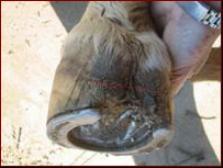 |
Why do the front feet deform first? I believe it's because of the unique role they play in the bio-mechanics of the horse which involves a lot of breaking and impulsion in an upwards direction. The hind hooves seem to stay in a better shape for longer, due to their very different role in locomotion which is more about digging in and driving the horse forwards.
If you don't know a thing about good hoof form and your horse isn't limping lame how can you know if the horse is sore?
Easy... just look at the way they choose to stand.
If you have a sore foot yourself and walk and stand avoiding the sore area, after a time you will find you have secondary problems such as a sore back or hip. Continue to adjust your posture for many years and eventually this will even lead to changes in your neck and amazingly, even your eyesight because you will carry your head tilted to offset the tilted hip. A checkerboard of problems will arise throughout your body. The same thing happens to horses.
To identify horses with hoof pain it is first necessary to identify the stance of a comfortable horse. We live in a world of sore horses and alarmingly most of us have come to accept their various abnormal postures as normal. We need to look again armed with some knowledge of why they are choosing to stand as they do.
Sadly over the years many of the early warning signs of hoof pain have been mistaken for conformational problems and even written about as such in well known equine texts. Horses are said to be "over at the knees" when in fact they have no knee problems at all and their strange stance stems from caudal hoof pain. Others have been said to have overly sloping pasterns when they are merely "forced" to have these due to abnormal P3 (pedal bone) alignments within the hoof capsule. This forces abnormal angles on the pasterns as the horse compensates.
No amount of corrective shoeing, remedial body work or chiropractic work will relieve upper body problems caused by constant postural adjustments due to hoof pain. It is the single greatest cause of musculo-skeletal issues in the domestic horse.
Normal Posture: Whether a young foal or an old horse they should be able to utilize fully their "stay apparatus" muscles of the forehand and partial stay apparatus of the hindquarters. To do so they must be able to keep their front legs vertical as illustrated below.
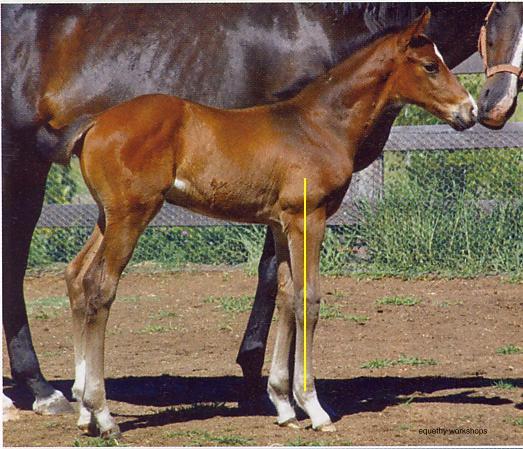 |
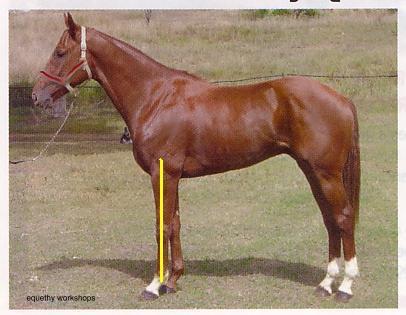 |
Notice the good definition of the musculature in the older horses neck & shoulders; the deep indent in front of the scapular (shoulder blade) in front of the withers. These forehand muscles are as they should be. Soft and flexible and normal size.
How to identify hoof pain: Simple! Sore horses lean forwards to unweight their sore heels.
Most of us are familiar with identifying limping lameness but what is so insidious about hoof deformation from shoeing is that the horses don't technically limp as pain develops equally in both front feet! So these horses can't limp in the clinical sense but are indeed lame.
Even if you don't know a single thing about the hoof except where it fits on the leg you can clearly see horses who adopt this forward posture. It's a huge warning light. If you see it in your shod horses they are already very sore.
|
|
|
The chest is clearly be seen to be held forward ahead of the legs to take the weight off the caudal hoof (heel area).
At first these postures are subtle, but as the hoof deformation and associated pain progresses so does the advanced forward leaning stance. The horse now adopts altered gaits as well. Riders may notice they are less forward going, less keen to stretch out. They become clumsy and begin to trip. Dressage riders find their horses begin to loose impulsion, show jumpers find they will start to run out on jumps or buck on landing, trail riders find their horses unwilling to travel downhill and tend want to creep down slowly or try to go down sideways.
Beware - the toe first landing!
These sore horses will try to do toe
first landings with every stride instead of the correct heel first landings
nature intended.
How can you tell? If
you look closely at a horse with hoof deformation land a stride you will see a
little spray of dirt shoot out ahead of the toe as the horse lands toe
first. These toe first landings cause the tripping and stumbling when the
toes dig in and butt against something solid in the ground surface. These
horses may also buckle at the knees if the horse has overly contracted and
weakened foreleg musculature due to postural adaptations from long term
problems.
|
Many racing thoroughbreds like the fellows at right, suffer early onset hoof deformation due to the practice of very early shoeing so common in that industry. Thoroughbreds are often shod when their hooves are barely past foal development. The bones of a horse do not mature till the horse is at least five years of age, this includes the bones of the hoof, some bones in the spine even later. So shoeing horses as yearlings puts them straight on a fast track for hoof problems. This early shoeing in the race industry has implications for both horse and rider as tripping and falling are not something that you would like to have happen to valuable horses who work at speed and carry a human life atop them. Another sinister consequence of toe first landings is the snapping effect that it causes to the tendons. This "whip lash" effect occurs as the horse drops its weight onto the hoof after a toe first landing. This tends to be a quick, uncontrolled and badly co-ordinated drop after a toe first landing without the dampening of concussion and controlled release that should normally happen. This "drop" causes continual micro-traumas to the tendon. The cumulative damage often leads to serious career ending tendon tears and suspensory damage. |
Note the very evident toe first landings (front and rear) on these three year olds! |
|
>Great heel first landings!
|
Most of the concussive shock is being absorbed in the caudal hoof and dissipated at ground level which will lead to less injuries during his performance career. Amazingly long distance riders
often notice that they also suffer less knee pain when they ride barefoot
horses! At left is Louise McCormack and Duo Park
Ume. Louise turned to barefoot trimming to rehabilitate
Ume who had been suffering lameness problems when competing
shod. It was discovered by vets that Ume had bone spurs on
both her forefoot pedal bones and a 90 percent tendon tear and they
suggested that she be retired as she would never be competition sound
again. Not everything is as it seems! |
Sore hooves lead to sore bodies:
Adopting a continual forward lean has horrendous consequences for the musculo-skeletal system. Firstly it creates dysfunctions in the "stay apparatus" muscles of the forehand. Later their entire locomotory musculature of the horse becomes involved from one end to the other due to secondary compensations.
The "stay apparatus" in the forehand works to lock the leg straight, from shoulder to pedal bone by exerting equal and opposite forces from shoulder to hoof, down through a system of muscles and tendons. This lock allows the horse to sleep and rest in a standing position. Not just something nice for horses to do, but an evolutionary necessity to avoid fatigue for an animal that lives most of the time on its feet.
When the horse has physiologically correct hoof form they hold the leg effortlessly in this lock, with practically no muscular effort; but the foreleg MUST be vertical for this system to work efficiently.
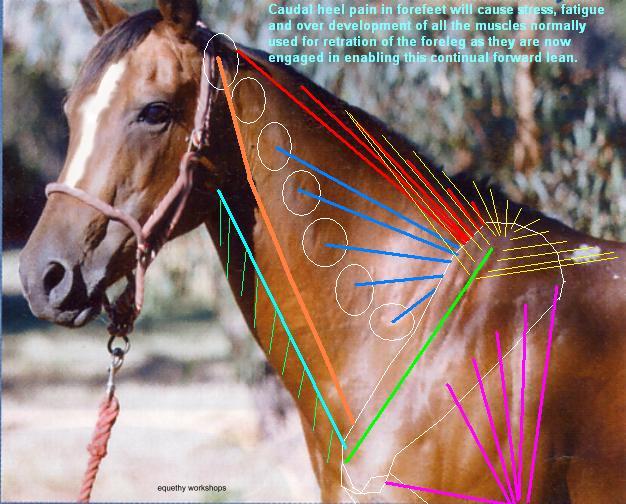
Horses who cannot "lock" their
foreleg stay apparatus
to rest must use other muscle groups in the
forehand to assist in keeping the forelegs straight
These extra muscles normally
would be involved
in locomotion and taking on a continual support role causes
them to over-develop, become fibrotic,
contracted and
fatigued.
Many horses are undergoing continual body therapies and chiropractic manipulations for problems that will only return again and again as the source of theses problems remains undiscovered and unchanged.... the deformed painful hooves.
Notice the over development of muscle groups in the shoulder and neck of this horse at above. He has no indentation in front of his scapular due to muscular over development and now has a thick and blocky neck.
Many equine body therapists are not trained to identify hoof deformation so unless they have developed an interest in barefoot rehab, to them, if the hooves look tidy and well shod and the horse is not limping lame they won't suspect hoof pain. I cannot stress how important learning about natural hoof care can be for any equine therapist. If you are working on horses and don't have this knowledge you have become part of the problem instead of part of the solution.
As the years pass and the hooves deform further, the pain increases. Muscles of the shoulders and upper legs become so fatigued and stressed from trying to maintain this lean that some horses actually adopt a slightly bent knee stance to gain some relief.
By now it's obvious to their owners that they have a serious problem and veterinary attention is sought. Usually the hoof deformation is not considered as the source because as yet many vets have not been exposed to barefoot rehab.
The old solution for these problems was and often still is, expensive and invasive salvage surgeries to cut ligaments or destroy nerves. After these surgeries the horse was put on a regime of corrective shoeing and pain medication for life. I believe this is merely palliative care. More of the very thing that caused the problems while the hoof deformation continues unchecked causing bone loss and bone deformities within the hoof capsule. By now these bony changes are clearly obvious on x-rays and so are thought to be the cause of the lameness when they are actually secondary changes due to the advanced hoof deformation.
If this course of action has been suggested to you by your vet you might like to contact a veterinarian who deals in natural hoof care rehabilitation and seek a second opinion. (Australian vets who can help you are listed on the website http://www.easycaredownunder.com.au/ under Hoof Care Providers).
I have not yet seen any case of navicular syndrome that has not dramatically improved with the use of natural hoof care and hoof boots. Many have become sound riding horses again and returned to their performance work.
Secondary hind quarter muscle problems from hoof pain -
"Reversed Angles" and their associated body issues.
As time goes on and the horse develops a checkerboard pattern of compensation throughout his body. Next hind quarter problems arise and lumbo-sacral pain and hamstring stiffness appear. This is due to the horse bracing their forehand which causes them to shift greater amounts of weight onto their hindquarters.
With this constant transference of weight off the forehand and onto the hind quarter the hind hooves become involved in the deformation process too. They begin to deform, and develop abnormal hoof angles and low heels. Often the angles on hind and forefeet become "reversed".
|
|
|
Professional Barefoot Trimmers know this "all hoof involvement" as Reversed angles or may call it the "Box Stance" so called because the posture appears as if the horse is standing on a small box like a circus elephant. Often the gluteals located in the rump become so stressed and tight that they appear like little pillows bulging up on both sides of the rump, even on thin horses.
How does this "box stance" happen to shod horses? It is easy to understand if you think about it. If the farrier is shoeing to match the increasing hoof deformity, and many do. Then as the heels crush and become lower the steel shoe prevents any wear or natural correction from happening. Shod like this the horse is forced to bring his hind hooves further and further underneath him just to stand and so places more and more weight on his hind heels.
The pedal bone (P3) of the forefeet, and hind feet have evolved to be slightly different in their shapes and the angle on their anterior surface is also slightly different. This is because the hind and fore hooves play different roles in the equine biomechanics and need to be slightly different in their shape and angle. The forefeet are basically used for braking and impulsion in an upward direction whilst the hind hooves are more trowel shaped to dig in and push, so providing the huge powerful thrusts necessary for speed.
For the horse to function effectively and in harmony with his bio-mechanics and avoid musculo-skeletal issues it has been my observation that they must have hind hooves at least four degrees steeper than the forefeet. Naturally steeper ....... not created by wedges or corrective shoes. Once they are the same or become "reversed" they are fighting their own biomechanics for every step.
Reversed angles cannot be artificially addressed with wedges or pads as it is the actual alignment of the pedal bone inside the hoof capsule that dictates the hoof shape and this affects the articlulation of the short & long pastern joints. Chocking heels up with wedges so that they look better is merely cosmetic, it actually crushes the heels further and tilts the pedal bone abnormally.
Horses with "reversed angles" need to GROW more heel height in the correct alignment. To do this the hoof must be encouraged back into a physiologically correct form. They must have their "fulcrum point " in the hoof capsule returned to the correct position so that their weight pivots at the anatomically correct point.
This can only be done by addressing the hoof deformity and encouraging the growing of a correct hoof form again. It usually takes about six months and they MUST be regularly trimmed every four weeks, but the rewards are great. As well as sound movement often the entire topline of the horse will change and redevelop. Many owners say that their horses look and move better after rehab. than they have since they were young.
Secondary Hock & Stifle problems Horses with reversed hoof angles often suffer patellar problems and hock and stifle issues. Often this is mistaken for locking patellar by owners and veterinarians who are unfamiliar with physiologically correct hoof form. The hock and stifle joints work with reciprocal action - flex one and the other flexes equally but opposite. What is not commonly known is that there is also a role played in patellar action by the tensor fascia latae muscle and the lumbo-sacral joint. All of these are affected by abnormal reversed angles as they are unable to work in concert as they should. In fact they are foced to work in opposition to each other. Working in opposition creates tight hamstrings and lumbo-sacral pain. This hock and stifle pain is often mistaken for arthritis in older horses.
Rehabilitation Therapies:
Barefoot rehabilitation is firstly aimed at halting and reversing the hoof deformation. You will be astounded at how powerful a tool this can be even for horses with serious hoof problems. Its best done with the guidance of a Professional Trimmer but if you don't have access to a professional there are many great books and dvds available now that will help you and your current farrier make a start in the right direction. Doing something is better than doing nothing. If you don't have access to a professional trimmer then march up to your farrier and hand him a copy of Pete Ramey's books or the Barefoot Blacksmith dvd's!
You will need to be strong and insist that your farrier take of leap of faith and follow proper barefoot methods and not make up his own version of a barefoot trim. It's your horse and you have a right to have him trimmed as you choose, stay committed. There is no such thing as a "sort of" barefoot trim. It will only leave your horse sore and stall your rehab as you will be removing important architecture from the hoof that it needs to redevelop properly and may not be removing the leverage forces that are the actual cause of the hoof deformation.
A professional trimmer will explain in detail what problems they see in
the hoof and assess what forces are causing the hooves to morph into an
unhealthy form. They will then do a set up trim which is stage one of your
rehabilitation. Followed up by regular trims aimed at encouraging the hoof to
grow in the correct form. If you can also find an equine massage
therapist to work in conjunction with the trimmer they can begin to release
tight contracted muscles right from the initial trim. This will speed up
the resolution of body problems.
Over the next few months and via
a series of regular trims, the hooves are slowly encouraged back into the
correct form. It's important that they are regular trims, no longer than four
weeks apart or you will be right back where you started every time the trimmer
comes. Regular trimming re-establishes the correct break-over point, hoof
balance and will return a normal range of motion to the joints. As this
happens the musculature also responds positively.
Right from Day One deal with those toe first landings: I cannot stress how important this is! You must provide boots and pads as part of the rehab process.
Horses that have had to deal with years of hoof pain will habitually do toe first landings. Their brain has become hard wired to move this way. When you remove their shoes they will hunch their shoulders when ridden trying to protect their sore feet. This "hunching" adds to their upper body problems and slows down their recovery. It is important that they "relearn" how to use there bodies correctly and to do so they have to feel one hundred percent confident about doing heel first stride landings.
Easycare Hoof boots with therapeutic pads are the very best thing to give confidence to these horses. They don't need them in the pasture because when at liberty they can take their time to move about and pick their footing, and exposure to varying surfaces is part of the rehab. process, but they do need them for any work or lunging you do.
Why? Dr. Robert Bowker's recent research using Ultrasound has shown that the greater the peripheral loading of the hoof (as with shoes) the worse the blood flow throughout. With less peripheral loading, the greater the perfusion of blood flow through the hoof. Better blood flow equals healthier hooves and faster rehab time. Horses that have been shod long term had their hoof constantly loaded only on the peripheral wall, suffering altered blood flow and all the damage that follows. So this has to be reversed. The digital cushion must be regenerated and as the hoof capsule regains structural integrity the heels will decontract somewhat too relieving the pressure in the caudal hoof area.
Solar loading by putting pads in boots promotes blood flow through the hoof. This constant all over contact mimics the stimulation that the hoof would receive naturally. Bowker's studies show that blood perfusion through the foot is highest when a hoof is on pea gravel and on foam pads, both rating at 90 on his index.
The very best and quickest way to regain physiologically correct hoof form and thus a sound horse without any musculo-skeletal problems, is to have regular trims and to give the horse gentle exercise in boots with pads. The horse's own weight in motion will strengthen the internal tissues of the hoof, and break up adhesions. For horses with shrivelled, non functional frogs there are even special therapeutic pads for extra stimulation.
It is pointless trying to rehab. serious hoof problems without providing hoof comfort as well, as you will be undoing your good work every time the horse is ridden. Unless they can comfortably land heel first again they will never rebuild the tissues of the digital cushion and caudal heel area.
Once the horse is comfortable its time to think about some "core strength exercises" to rebuild their musculo-skeletal strength and create self carriage again. I don't mean exercises that require collection, I mean exercises that will create suppleness and length in the areas of overdevelopment. Talk to your therapist about an exercise plan.
Barefoot is not about being "bare". It's about a better quality of life....... for the horse's entire life. Good luck with your rehab. You will be greatly rewarded for your efforts.
Chrisann Ware
Equethy Barefoot Educational Workshops (Australia)
http://www.equethy.com/ & Easycare Down Under http://www.easycaredownunder.com.au/